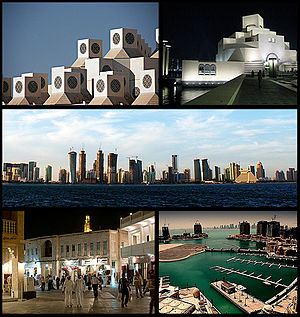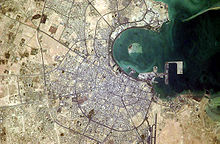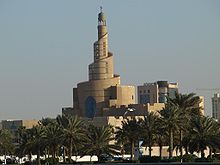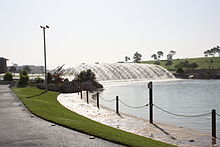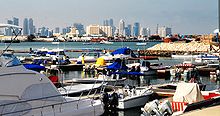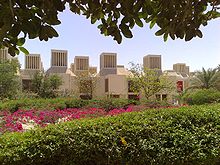- Doha
-
For other uses, see Doha (disambiguation).
Doha
الدوحة ad-Dawḥa— City and Municipality — From top: Qatar University, Museum of Islamic Art, Doha Skyline, Souq Waqif, The Pearl Location of the municipality of Doha within Qatar. Coordinates: 25°17′12″N 51°32′0″E / 25.28667°N 51.533333°ECoordinates: 25°17′12″N 51°32′0″E / 25.28667°N 51.533333°E Country  Qatar
QatarMunicipality Ad Dawhah Established 1850 Area – City 132 km2 (51 sq mi) Population (2011) – City 1,450,000 – Density 10,984.8/km2 (28,450.6/sq mi) Time zone AST (UTC+3) Doha (Arabic: الدوحة, ad-Dawḥa or ad-Dōḥa, literally: "the big tree") is the capital city of the state of Qatar. Located on the Persian Gulf, it had a population of 998,651 in 2008,[1] and is also one of the municipalities of Qatar. Doha is Qatar's largest city, with over 80% of the nation's population residing in Doha or its surrounding suburbs, and is also the economic centre of the country.
Doha also serves as the seat of government of Qatar, which is ruled by Sheikh Hamad bin Khalifa Al Thani. Doha is home to the Education City, an area devoted to research and education. Doha was the site of the first ministerial-level meeting of the Doha Development Round of World Trade Organization negotiations. The city of Doha also held the 2006 Asian Games, which was the largest Asian Games ever held. It will also be the venue of the 2011 Pan Arab Games which will be from December 9th to 23rd. It hosted the AFC Asian Cup 2011 and will also host a large number of the venues for the 2022 FIFA World Cup. Doha is currently bidding to host the 2020 Summer Olympics. [2]
Contents
History
In 1825, the city of Doha was founded under the name Al-Bida. The name "Doha" came from the Arabic ad-dawha, "the big tree." The reference might be to a prominent tree that stood at the site where the original fishing village arose, on the eastern coast of the Qatar peninsula. Or it might have been derived from "dohat" — Arabic for bay or gulf — referring to the doha bay area surrounding corniche. In 1825, during the war between Qatar and Bahrain, Doha had been severely damaged and Abu Dhabi was helping Bahrain.[3] In 1882, al Rayyan built the Al Wajbah fortress, in southwestern Doha. The following year, Sheikh Qassim led a Qatari army to victory against the Ottomans.
The city was made capital of the British protectorate of Qatar in 1916, and when the nation gained independence in 1971.
In 1917, the Al Kout fortress, which is located in the center of the city, was built by Sheikh Abdulla Bin Qassim Al-Thani. Still, during the early 20th century, much of Qatar's economy depended on fishing and pearling, and Doha had about 350 pearling boats. However, after the introduction of the Japanese cultured pearls in the 1930s, the whole region, including the town of Doha, suffered a major depression and Qatar was plunged into poverty. This lasted until in the late 1930s, when oil was discovered. However, the exploration and exportation was halted due to the second world war. Today the nation as a whole produces over 800,000 barrels of oil daily. In 1969, the Government House opened. Today it is considered to be Qatar's most prominent landmark.
The first mention of Al Bida in English sources appeared in 1765, on a rather inaccurate map by Carsten Niebhur, in which Al Bidda is referred to as Guttur. Carsten had not visited Qatar personally, and had relied on the knowledge of local Arabs and English sea captains to fill in this section of his map. In the nineteenth century, Doha was little more than a small village which was known as Al Bida. In 1820, Major Colebrook described it thus:
"Guttur – Or Ul Budee [Al Bidda], once a considerable town, is protected by two square Ghurries near the sea shore; but containing no fresh water they are incapable of defence except against sudden incursions of Bedouins, another Ghurry is situated two miles inland and has fresh water with it. This could contain two hundred men. There are remaining at Uk Budee about 250 men, but the original inhabitants, who may be expected to return from Bahrein, will augment them to 900 or 1,000 men, and if the Doasir tribe, who frequent the place as divers, again settle in it, from 600 to 800 men.''"
However, the small size of the place didn't stop it from being bombarded by the British vessel Vestal in 1821, after the city had been deemed to have broken a general treaty of peace. They were bombed again in 1841 after Al-Suwaidi, the Sudanese chief who then ruled Al Bidda, was accused of habouring an outlaw, and the village was destroyed in 1847 after its leader – Bin Tarif Bin Salamah – had been killed in battle against the Al Khalifas of Bahrain near Fuweirat. These major disturbances were probably also punctuated by the customary raids of the nomadic Bedouin;]: raids which would not stop for another hundred years.
At some point after this destruction, the Al Thani family moved from Fuwairet to Al Bidda, for when the British Resident visited the village he found that Sahikh Mohammed Al Thani was now chief of Doha. Doha was now a separate village close to Al Bidda, and in between Al Bidda and Doha lay little Doha, only four hundred yards form Al Bidda. Paradoxically, the roots of its future as the capital of Qatar lay when Doha, along with Al Wakra, were attacked again – by Bahrain in 1867, aided by Abu Dhabi. Doha and Al Wakra attempted to retaliate in a very bloody sea battle.
The British, who wished to avoid disruption to trade and were angry that the Al Khalifas of Bahrein had broken a treaty forbidding maritime warfare in the area, came to Qatar and were met by the headman of Al Bida, Sahikh Mohamad Bin Thani, on behalf of "all the Sheikhs and tribes" in the peninsula. This meeting was, eventually, to lead to Qatar becoming a nation state under the Al Thanis. For a time Ottomans took up a rather nominal control of the country, with a base in Doha, with the acquiescence of Qassim Al Thani, who wished to consolidate his control of the area. However, disagreement over tribute and interference in internal affairs arose which eventually led to battle in 1893. The Ottomans were defeated and retreated to their small fort in the centre of Doha, where they remained until they finally left during the first world war. Partly as a result of the departure of the Ottomans, Qatar was made a formal British protectorate in 1916, with Doha as its capital.
At around the turn of the century, Doha had a population of around 12,000 and around 350 pearling boats. However, the growth of trade in cultured pearls from Japan began to impact upon the region, and this was exacerbated by the depression of the 1930s.
The exploitation of Qatar's oil reserves after the end of the second world war was to save the city, although it was to be some time before the source of their current and future wealth – natural gas – was exploited.
Buildings at the time were simple dwellings of one or two rooms, built from mud, stone and coral. However, the Amirs of Qatar were not long in exploiting the new-found wealth, and slum areas were quickly razed to be replaced by more modern buildings. As with other countries in the region, in this rush to modernise much of the country’s heritage was lost, and in Doha now there is only a single remaining wind tower. The astonishing development of Doha, and the changing shape of the bay, can be seen to this day in Qatar’s National Museum. Doha was a port of some local significance. However, the shallow water of the bay prevented bigger ships from entering the port until the 1970s, when its deep-water port was completed. Further changes followed with extensive land reclamation, which led to the crescent-shaped bay that we can see today.
In 1973, the University of Qatar opened, and in 1975 the Qatar National Museum opened in what was originally the ruler's palace in 1912. The Al Jazeera Arabic satellite television news channel began broadcasting from Doha in 1996. Sheikh Hamad Bin Khalifa Al-Thani currently rules in what some consider to be Qatar's most beautiful city.
By 2010, Qatar had a population of 1,696,563, making it one of the world's fastest-developing countries.
Climate
Doha features an arid climate. It is situated in the Arabian Peninsula, and as such its climate is very hot. Temperatures average over 38 °C (100 °F) from May to September, and humidity is variable. Dewpoints can reach above 25 °C (77 °F) in the summer. During the summer months, the city averages almost no precipitation, and less than an 20 mm (0.79 in) during other months.[4] Rainfall is scarce, at an average of 75 mm (2.95 in) per annum, falling on isolated days mostly between October to March. Winters are mild, and the temperature rarely drops below 7 °C (45 °F).
Summer temperatures frequently reach 50 °C and above.
Doha Climate chart (explanation) J F M A M J J A S O N D 1322131723141627178.732213.63825041280422904129039271.135233.33020122415Average max. and min. temperatures in °C Precipitation totals in mm Source: WMO Imperial conversion J F M A M J J A S O N D 0.571550.773570.680620.389690.110177010682010784010584010180095740.185670.57559Average max. and min. temperatures in °F Precipitation totals in inches Climate data for Doha Month Jan Feb Mar Apr May Jun Jul Aug Sep Oct Nov Dec Year Average high °C (°F) 21.7
(71.1)23.0
(73.4)26.8
(80.2)31.9
(89.4)38.2
(100.8)41.2
(106.2)41.5
(106.7)40.7
(105.3)38.6
(101.5)35.2
(95.4)29.5
(85.1)24.1
(75.4)32.70
(90.86)Average low °C (°F) 12.8
(55.0)13.7
(56.7)16.7
(62.1)20.6
(69.1)25.0
(77.0)27.7
(81.9)29.1
(84.4)28.9
(84.0)26.5
(79.7)23.4
(74.1)19.5
(67.1)15.0
(59.0)21.58
(70.84)Rainfall mm (inches) 13.2
(0.52)17.1
(0.673)16.1
(0.634)8.7
(0.343)3.6
(0.142)0
(0)0
(0)0
(0)0
(0)1.1
(0.043)3.3
(0.13)12.1
(0.476)75.2
(2.961)Source: World Meteorological Organisation (UN)[5] Demographics
The demography of Doha is unusual in that the majority of residents are expatriates, with Qatari nationals forming a minority. The largest portion of expatriates in Qatar are from South Asian countries, mainly Pakistan, India, Sri Lanka, Nepal, Philippines, Bangladesh and Indonesia, with large amounts of expatriates also coming from the Levant Arab countries, North Africa, and East Asia. Doha is also home to expatriates from the United Kingdom, United States, Canada, France, South Africa, and Australia as well as many other countries from all over the world.In the past, expatriates in Qatar were not allowed to own land; however, now people who are not Qatari citizens can buy land in several areas of Doha, including the West Bay Lagoon, the Qatar Pearl and the new Lusail City. Ownership by foreigners in Qatar entitles them to a renewable residency permit, which allows them to live and work in Qatar.
Each month, thousands emigrate to Qatar, and as a result, Doha has witnessed explosive growth rates in population. Doha's population currently stands at around one million,[6] with the population of the city more than doubling in the past decade. Due to the high influx of expatriates, the Qatari housing market saw a shortage of supply which led to a rise in prices and increased inflation. The gap in the housing market between supply and demand has narrowed, however, and property prices have fallen in some areas following a period which saw rents triple in some areas.[7]
Several churches have recently been constructed in Doha, following decrees by the Emir for the allocation of land to churches. In March 2008, the first Catholic Church in Doha, Our Lady of the Rosary, was opened. As a sign of respect to the local (Muslim) population,[citation needed] Christian symbols are not displayed on the outside of the building. Today, several churches exist in Doha, including the Malankara Orthodox Church, Mar Thoma Church (affiliated with the Anglicans, but not part of the Communion), CSI Church, Syro-Malankara Church and the Pentecostal Church.
Year Population Metro 1986 217,294[3] 1992 313,639[3] [8] 2001 299,300[9] 2004 339,847[10] 612,707 2005 400,051[11][12] 2008 998,651[6] The following table shows the registered live births by nationality and sex for this municipality. [13][14]Place of births is based on home municipality of mother at birth.
Registered live births by nationality and sex Year Qatari Male Qatari Female Total Qatari Non Qatari Male Non Qatari Female Total Non Qatar Total Male Total Female Grand Total 2001 1045 1035 2080 1878 1741 3619 2923 2776 5699 2002 932 943 1875 1877 1780 3657 2809 2723 5532 2003 1104 1068 2172 2064 1963 4027 3168 3031 6199 2004 1054 1000 2054 1946 1814 3760 3000 2814 5814 2005 867 900 1767 2007 1892 3899 2874 2792 5666 2006 961 947 1908 2108 2008 4116 3069 2955 6024 2007 995 918 1913 2416 2292 4708 3411 3210 6621 2008 955 895 1850 2660 2623 5283 3615 3518 7133 2009 1098 1043 2141 3025 2954 5979 4123 3997 8120 Districts
The following is a list of some of Doha's more prominent districts:
- Al Bidda البدع
- Bin Mahmoud فريج بن محمود
- Al Dafna الدفنة
- Al Hilal الهلال
- Madinat Khalifa مدينة خليفة
- Al Mamoura المعمورة
- Al Markhiya المرخية
- Al Nasr النصر
- Old Airport المطار القديم أو المطار العتيق
- Onaiza عنيزة
- Qutaifiya القطيفية
- Ras Abu Aboud راس أبو عبود
- Al sadd (Qatar) السد
- Rumeilah الرميلة
- Al Waab الوعب
- Wadi Al Sail وادي السيل
- West Bay (Doha) الخليج الغربي

Doha's skyline seen from the south side of Doha Bay, with the Museum of Islamic Art in the foreground. Economy
See also: Economy of Qatar and List of tallest buildings in Doha, QatarMuch of Qatar's oil and natural gas wealth is visible in Doha, which is the economic centre of Qatar. Doha is home to the headquarters of the country's largest oil and gas companies, including Qatar Petroleum, Qatargas and RasGas. Doha's economy is built on the revenue the country has made from its oil and natural gas industries, and the Qatari government is rapidly trying to diversify the Qatari economy in order to move away from this dependence on oil. As a result, Doha is currently experiencing a very large boom, with the city developing very rapidly – this is mostly the result of Sheikh Hamad bin Khalifa's modernization program.
Like the nearby city of Dubai in the United Arab Emirates, Doha's economy is moving away from its dependency on the oil and natural gas industries, although unlike Dubai, Doha's main focus is not tourism. Doha is seeing huge amounts of growth, with the population of the city increasing by more than 30,000 between 2004 and 2006; this has caused a boom in the real estate sector, with real estate prices skyrocketing.[15] According to the BBC, as of late January 2007, Doha is now a more expensive city than Dubai in terms of real estate prices. This rate of growth has led to projects such as the Lusail City project, which is being constructed north of Doha and will eventually house 200,000 people. Construction is also booming in Doha, a result of increasing corporate and commercial activity in Doha. This is most visible with the changing skyline of the city, as Doha has over 50 towers currently being constructed, the largest of which is the Dubai Towers. At the same time, 39 new hotels are joining Qatar's booming tourism market, adding about 9,000 new rooms by 2009.
Qatar Airways is headquartered in the Qatar Airways Tower in Doha.[16]
Some key projects in Doha include:
- Aspire Tower
- Education City
- Museum of Islamic Art
- The Pearl
- Lusail
- Al Waab City
- Dubai Towers - Doha
- Commercialbank Plaza
- Msheireb Enrichment Center of Msheireb Properties and the Msheireb Downtown Doha
-
Construction along the Doha Corniche.
-
The old and new zones of Doha are clearly visible from the International Space Station.
Transportation
Doha has recently been undergoing a huge expansion to its transportation network, including the addition of new highways, the construction of a new airport, and the planned construction of a metro system. This has all been as a result of Doha's massive growth in a short space of time, which has resulted in congestion on its roads.
Roads
Doha has a comprehensive road network made up primarily of two and three lane dual-carriageways. As a result of Doha being a relatively young city, Doha's roads are wide and usually include service roads and large central dividers. While traditionally roundabouts have been used as intersections in the city, this has recently changed as a result of the huge load on the city's road networks. Many major roundabouts have been removed and instead either replaced with traffic lights or with underpasses and overpasses. Furthermore, many major thoroughfares in the city are being converted into highways in order to accommodate the huge increase of traffic on the city's roads.
Highways
There are five main highways connecting Doha to its neighboring cities. These are the Dukhan highway to the west of the city, the Al-Shamal Road, connecting Doha to the north of the country, the Al-Khor Expressway, connecting Doha to the northern town of Al-Khor, and the Wakrah/Messaid Road, connecting Doha to the south of the country. Finally, Salwa Road runs through south Doha and connects the city to the Saudi border to the south.
These highways are all currently undergoing expansion, and are being expanded within Doha itself.
Doha Expressway
The Doha Expressway, also known as the D-Ring Road, is a three-lane dual carriageway that connects the city on a north-south axis. To ease congestion, the D-Ring Road was converted into a major highway through the city between 2006 and 2010, connecting important districts of Doha and connecting Doha with the north of Qatar. Several expansions are planned for the expressway, including connections to the New Doha International Airport and a new route connecting Doha with Al Wakrah.
The Doha Expressway connects with the Al Shamal Road in the north of the city. The Al Shamal Road was recently expanded to a four-lane fully grade separated highway (a total of eight lanes). Through the Al Shamal Road, the new Doha Expressway will connect Doha with the planned Qatar-Bahrain Friendship Bridge at al-Zubarah, connecting the two Gulf states in a similar manner to the way in which Bahrain and Saudi Arabia are currently connected.
Lusail Expressway
The Lusail expressway is expected to connect the new city of Lusail, currently being constructed north of Doha, to central Doha, along with connecting the Pearl to the mainland. The expressway is expected to take the path along the former Istiqlal Road, now Lusail St., and will be a 4-lane dual carriageway passing through the city. The expressway will extend from Lusail City, through Rainbow roundabout, Qatar Sports Club roundabout, and the fire department roundabout.
Dukhan Highway
The existing Dukhan highway has been undergoing a reconstruction project for several years, with new interchanges having been constructed and the road being significantly expanded. In the future, it is planned to expand the highway so that it connects directly into Doha through a system of underpasses and overpasses, with plans to replace the Tilted Roundabout, the Markhiya Roundabout, and the TV Roundabout, all major roundabouts in Doha, with underpasses and overpasses.
Salwa Highway
The Salwa Highway project's first phase has been completed. This phase involved the expansion of the highway, which connects Doha to the southwestern town of Salwa on the Saudi Arabian border, into a four-lane highway with grade separated interchanges. The rest of Salwa Road is expected to be expanded and upgraded, from the recently completed Industrial Interchange to the Jaidah flyover, including the construction of an underpass at the Ramada signals, Doha's busiest traffic light intersection. This project is not expected to commence until after the completion of the Doha Expressway.
F-Ring Road
The F-Ring Road will be the sixth ring road in Doha, and is being constructed as part of the transportation network leading to the New Doha International Airport. The new highway will connect the airport to the Corniche at the new Ras Abu Aboud interchange, currently under construction, and will involve a new ring road south of the E-Ring Road.
Bus system
An extensive bus system, operated by the government-owned Mowasalat company, currently operates in the city of Doha. The bus system covers many areas of the city, and there are stops throughout the city. The bus system is mainly used by lower-income groups, and does not attract many from the higher-income groups in the city, which has resulted in increased congestion on the roads of Doha, as most people prefer cars.
The main bus station is located in the Souqs area of downtown Doha, and services operate to all major towns in Qatar.
Taxis
The Mowasalat company operates all taxis in Qatar under its Karwa brand, with over a thousand taxis operating in the capital. There are a few taxi stands in the city, and difficulties arise in finding taxis due to the small number of taxis on the roads. It is not possible to book a taxi for immediate use.
The majority of taxis are well-equipped, comfortable sedans including cars such as the Toyota Camry and more recently Skoda, Chevrolet and Volkswagen have been added to the ranks.
Airport taxis, found at the Doha International Airport, are also available, in the form of the Ford Freestar.
Numerous unlicensed taxis operate in Doha.
Port
The Doha Port is among the country's largest ports, and is located just off the Doha Corniche. The port is the main seaport servicing Doha, although plans for a new port are underway due to the port's location in central Doha and the resultant traffic and pollution problems, the proposed location of the port is near the town of Al Wakra, just south of the New Doha airport.
Air
For more details on this topic, see Doha International Airport.For information on the new airport under development, see New Doha International Airport.Doha International Airport is Qatar's only international airport. It is the hub of Qatar Airways, and is served by many other international airlines. Because of the rapid growth in Qatar and the rapid growth of Qatar Airways, many now consider the airport too small and unable to properly handle all of the traffic that goes through the airport. This problem was recently addressed with a large expansion that was made in anticipation of the 15th Asian Games. In order to accommodate increased traffic, the airport's facilities were expanded significantly, including the construction of a separate terminal dedicated to first and business class passengers, and expansion of the current terminal. Furthermore, new stands have been constructed on the opposite side of the runway to handle additional air traffic. These changes have temporarily eased the problem, but because of the airport's small size and limited space for expansion, this has not been enough to permanently solve the problem of the airport crowding.
A new airport, the New Doha International Airport, is being constructed near the existing airport (about 3 miles east[17]), and should solve the problems the current airport has.[18] The first phase of the airport should be completed in late 2009 or early 2010 along with the second phase, and will be able to accommodate 25 million passengers annually. Upon the completion of the third phase in 2015, the airport is expected to be able to handle up to 50 million passengers annually.[19] The new airport is located further away from the central areas of the city than the current airport, reducing noise and environmental pollution.[17] The projected total cost of the New Airport is $22 billion.
When the airport is completed, it will cover 2,200 hectares.[17]
The Al Udeid Air Base, a major U.S. Air Force airbase, is located southwest of Doha.
Education
See also: Education in QatarEducation has been a major focus of the Qatari government in recent years. In addition to Qatar University, established in 1973, the government has solicited other universities to establish campuses in Doha, most notably at Education City.
Education City is one of the main projects of the non-profit organization Qatar Foundation for Education, Science and Community Development. It has also launched the World Innovation Summit for Education (WISE), a global forum that brings together education stakeholders, opinion leaders and decision makers from all over the world to discuss educational issues. The first edition will be held in Doha, Qatar from November 16 to 18, 2009.
A key player in the educational field in Qatar is the Supreme Council of Communication and Information Technology ictQATAR. Through its e-education program, ictQATAR is bringing together the power of education and ICT in Qatar.
Doha is also home to many international schools established for its expatriate communities, with dozens of different private schools currently operating in the city, such as
Schools within and around Doha:
- Qatar Academy
- Qatar International School
- The American School of Doha
- Lebanese School
- Doha College
- DeBakey High School for Health Professions at Qatar
- The Qatar Canadian School
- Philippine School Doha
- Bangladesh M.H.M High School & College, Doha-Qatar
- MES Indian School
- DPS-Modern Indian School, Doha-Qatar
- Ideal Indian School
- Doha Modern Indian School
- The Cambridge School (Doha)
- Newton International School
- Shantiniketan Indian School (wakra)
- Birla Public School, Doha-Qatar
- Compass International School
- Qatar Leadership Academy, Al Khor
Universities/colleges within Education City: (See Education City)
- Virginia Commonwealth University
- Weill Cornell Medical College in Qatar
- Texas A&M University at Qatar
- Carnegie Mellon University in Qatar
- Georgetown University School of Foreign Service in Qatar
- Northwestern University in Qatar
Other Universities/colleges around Doha:
- Qatar University
- College of the North Atlantic
- CHN University
- University of Calgary
Sports
Doha is home to a number of sports stadiums, many of which were renovated in preparation for the 15th Asian Games, held in December 2006, which Doha spent $2.8 billion for preparation. Doha also hosted the 3rd West Asian Games in December 2005. Doha is also expected to host the 2011 Asian Indoor Games; Doha was also host the finals for the 2011 AFC Asian Cup. Qatar is aiming to be the region's sports capital.
Sports venues in Doha and its suburbs include:
- Hamad bin Khalifa Stadium – Al-Ahly Stadium
- Thani bin Jassim Stadium – Al-Gharrafa Stadium
- Jassim Bin Hamad Stadium (Al Sadd Stadium)
- Al Rayyan Stadium- Ahmed bin Ali Stadium
- Al-Arabi Stadium – Grand Hamad Stadium
- Hamad Aquatic Centre
- Khalifa International Stadium – Main venue for the 2006 Asian Games.
- Khalifa International Tennis Complex
- Qatar Sports Club Stadium
ASPIRE Academy, launched in 2004, is a sports academy which aims to create world-class athletes. It is situated in the Doha Sports City Complex, which also includes the Khalifa International Stadium, the Hamad Aquatic Centre and the Aspire Tower.
The MotoGP motorcycling grand prix of Doha is held annually at Losail International Circuit, located just north of the city.
Under-construction stadiums/sport facilities:
The Wall Stadium would become the world's largest underground stadium, dwarfing the Fjellhallen ice-hockey arena in Norway, and would be the main venue for the 2011 AFC Asian Cup.[23] The stadium is estimated to cost 20 million dollars. The stadium will have the latest technology and roads leading to the stadium will be easy. While the New Paralympic stadium south of the new City of Lusail will be the most advance Paralympic stadium.
In 2001, Qatar also became the first country in the Middle East to hold a women's tennis tournament: Qatar holds both the Qatar Open for Women and the ladies ITF tournament. Since 2008 and at least for 3 years, the Sony Ericsson Championships (equivalent to the ATP's season-ending Championships) takes place in Doha, in the Khalifa International Tennis Complex, and features record prize money of $4.45 million (check of $1,485,000 for the winner, which represents the largest single guaranteed payout in women's tennis today[24]).
Doha submitted a bid for the 2016 Olympics.[25] It already had more than 70% of the venues ready that were used during the Asian Games in 2006. If Doha had won, an olympic village would have been constructed and would have had the shape of a dove and been 67 hectares in size with a capacity of 18,000 people, housing officials, athletes and coaches.[26] (See Doha 2016 Olympic bid) On June 4, 2008, the city was eliminated from the shortlist for the 2016 Olympic Games. On August 26, 2011 it was confirmed that Doha would bid for the 2020 Olympics. [27]
In November 2009, Doha hosted the The Oryx Cup World Championship. This is a hydroplane boat race in the H1 Unlimited season. The race took place in Doha Bay on the Persian Gulf. The H1 Unlimited and the Qatar Marine Sports Federation (QMSF) agreed to have the final race of the 2009 H1 Unlimited unlimited hydroplane season in Doha. Ten of the fastest racing boats in the world traveled to Doha November 2009 for the inaugural Oryx Cup event—the H1 Unlimited World Championship—as a result of an Agreement in Principle reached January 9 between the ABRA and the QMSF.
In December 2010, Qatar won the rights to host the 2022 FIFA World Cup, and bring the event to the region for the first time. As a result of Qatar's harsh summers and the small population of the country, the bid contained several unique elements which were unprecedented in World Cup history. The winning bid proposed that all stadiums constructed to host the World Cup would be built as air conditioned indoor venues, in order to ensure that the event could be held in summer.
-
View of the Doha Sports City during the 2006 Asian Games opening ceremony.
-
Jet ski riders, a common view near the Doha Corniche during evenings.
-
View of the ASPIRE dome.
Culture and Arts
Qatar has a diverse and growing arts and entertainment industry.
Film
The Doha Film Institute (DFI) is an organisation established in 2010 to oversee film initatives and create a sustainable film industry in Qatar. DFI was founded by H.E. Sheikha Al Mayassa bint Hamad bin Khalifa Al-Thani.[28]
The Doha Tribeca Film Festival (DTFF) is Qatar's annual film festival organised by DFI. In 2011 the festival will take place between October 25 – 29 2011 at Katara Cultural Village in Doha.
Twin towns and sister cities
 Amman, Jordan (since 1995)
Amman, Jordan (since 1995) Beijing, China (since 2008)
Beijing, China (since 2008) Bosaso, Puntland State of Somalia (since 1994)
Bosaso, Puntland State of Somalia (since 1994) Brasília, Brazil
Brasília, Brazil Houston, United States
Houston, United States Marbella, Spain
Marbella, Spain Port Louis, Mauritius
Port Louis, Mauritius Stratford-upon-Avon, United Kingdom
Stratford-upon-Avon, United Kingdom Tunis, Tunisia
Tunis, Tunisia
See also
- Doha Declaration
- The Doha Development Round of World Trade Organization (WTO) talks
- Qatar National Day which is held in Doha every year on December 18th
References
- ^ "Doha 2016 Summer Olympics Bid". Gamesbids.com. http://www.gamesbids.com/english/bids/dha2016.shtml. Retrieved 2010-06-27.
- ^ http://www.olympic.org/media?articleid=138217
- ^ a b c Encyclopædia Britannica. "Doha – Britannica Online Encyclopedia". Britannica.com. http://www.britannica.com/EBchecked/topic/168027/Doha. Retrieved 2010-06-27.
- ^ "Doha weather information". Wunderground.com. 2010-06-10. http://www.wunderground.com/NORMS/DisplayIntlNORMS.asp?CityCode=41170&Units=both. Retrieved 2010-06-27.
- ^ "World Weather Information Service – Doha". http://worldweather.wmo.int/116/c00221.htm. Retrieved 2010-12-04.
- ^ a b "Doha 2016 Summer Olympic Games Bid". Gamesbids.com. http://www.gamesbids.com/english/bids/dha2016.shtml. Retrieved 2010-06-27.
- ^ http://www.business24-7.ae/Articles/2009/6/Pages/08062009/06092009_a7cd774da2cb4b1eb50cc316ad01ad8c.aspx
- ^ Capital Doha Population 484
- ^ "Doha". Tiscali.co.uk. 1984-02-21. http://www.tiscali.co.uk/reference/encyclopaedia/hutchinson/m0003599.html. Retrieved 2010-06-27.
- ^ "Sudan Airways – Doha". Sudanair.com. http://www.sudanair.com/qatar.htm. Retrieved 2010-06-27.
- ^ "Sheraton Doha Hotel & Resort | Hotel discount bookings in Qatar". Hotelrentalgroup.com. http://www.hotelrentalgroup.com/Qatar/Sheraton%20Doha%20Hotel%20&%20Resort.htm. Retrieved 2010-06-27.
- ^ http://www.hotelsdoha.eu/
- ^ [1]
- ^ [2]
- ^ http://www.qsa.gov.qa/Eng/publication/annabs/2009/demographics_social_2009/Population-2009.xls
- ^ "Worldwide Offices." Qatar Airways. Retrieved on 9 February 2009.
- ^ a b c "Global Perspectives – Qatar's New Doha International Airport". AirguideOnline.com. http://www.airguideonline.com/airguidemonthly/airguide0633.htm. Retrieved 2010-06-27.
- ^ "New Doha International Airport presents credentials at leading industry forum, AME Info, 2006-09-26". Ameinfo.com. 2007-03-02. http://www.ameinfo.com/97394.html. Retrieved 2010-06-27.
- ^ "Information on the New Doha International Airport". Airport-technology.com. http://www.airport-technology.com/projects/doha/. Retrieved 2010-06-27.
- ^ "View Single Post – U/C: the Wall Stadium (MZ& Partners)". SkyscraperCity. 2007-10-25. http://www.skyscrapercity.com/showpost.php?p=16094915&postcount=21. Retrieved 2010-06-27.
- ^ 10:21 AM. "View Single Post – Doha votes to host the olympics 2016 !!!". SkyscraperCity. http://www.skyscrapercity.com/showpost.php?p=16101485&postcount=270. Retrieved 2010-06-27.
- ^ "Olympic Bid News and Information Website". GamesBids.com. http://www.gamesbids.com/cgi-bin/news/viewnews.cgi?category=1&id=1207052573. Retrieved 2010-06-27.
- ^ "View Single Post – #News: Qatar bids to host 2011 Asian Cup". SkyscraperCity. http://www.skyscrapercity.com/showpost.php?p=16159543&postcount=17. Retrieved 2010-06-27.
- ^ "Season to End in Doha 2008–2010" on the Sony Ericsson WTA Tour website
- ^ "Information on 2016 Olympic Games Bids". Gamesbids.com. http://www.gamesbids.com/english/bids/2016.shtml. Retrieved 2010-06-27.
- ^ Doha 2016[dead link]
- ^ http://espn.go.com/olympics/story/_/id/6898802/doha-bid-right-host-2020-summer-olympics
- ^ Article in Variety Arabia
External links
- Doha travel guide from Wikitravel
- Projects in Doha and major construction and architectural developments
- Information and History of Doha
- Doha Shopping Malls
Capitals of Arab countries Africa Asia - Cairo 1996 (Egypt)
- Tunis 1997 (Tunisia)
- Sharjah 1998 (United Arab Emirates)
- Beirut 1999 (Lebanon)
- Riyadh 2000 (Saudi Arabia)
- Kuwait 2001 (Kuwait)
- Amman 2002 (Jordan)
- Rabat 2003 (Morocco)
- San'a 2004 (Yemen)
- Khartoum 2005 (Sudan)
- Muscat 2006 (Oman)
- Algiers 2007 (Algeria)
- Damascus 2008 (Syria)
- Jerusalem 2009 (Jerusalem)
- Doha 2010 (Qatar)
- Sirte 2011 (Libya)
- Manama 2012 (Bahrain)
- Baghdad 2013 (Iraq)
Municipalities of Qatar Ad Dawhah · Al Ghuwariyah · Al Jumaliyah · Al Khor · Al Wakrah
Al Rayyan · Jariyan al Batnah · Madinat ash Shamal · Umm Salal · Mesaieed Categories:
Categories:- Arab Capital of Culture
- Doha
- Capitals in Asia
- Municipalities of Qatar
- Populated coastal places in Qatar
- Populated places established in 1825
- Populated places in Qatar
Wikimedia Foundation. 2010.

